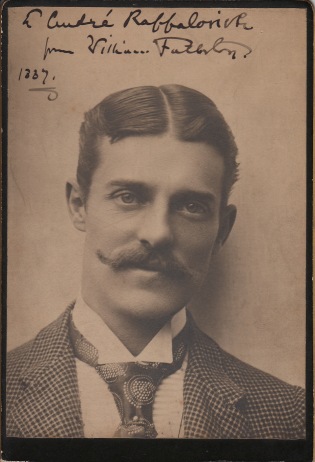From Gerald W. Cloud, Clark Librarian
At the 46th California International Antiquarian Book Fair in San Francisco last month I asked Ed Maggs the question I ask as many booksellers as will listen, “Do you have any Wilde material?” Ed replied that he did indeed and produced from his glass-fronted cabinet the photograph shown here:

William Morton Fullerton (1865-1952)
Portrayed here is William Morton Fullerton (1865-1952), in an original cabinet portrait, inscribed “To André Raffalovich from William Fullerton. 1887.” A quick check of the Clark’s catalog revealed that the library already owned correspondence between Wilde and Fullerton (in particular, a four page letter which Mr. Clark acquired in the Dulau sale, described thus: “Addressed from Paris, 1899. Commencing ‘Monsieur Melmoth’. A pathetic letter, refusing with extreme politeness and reluctance a request for a loan” [Dulau, 96]).
Hoping for a good story I asked, “But who was William Fullerton?” Mr. Maggs did not disappoint, and he kindly provided the follow account:
“William Morton Fullerton was one of the most interesting non-entities of the fin-de-siècle. His early literary talent never really developed throughout a career of jobbing journalism that peaked early with his coverage for The Times of the Dreyfus trial, and he is remembered now for the astonishing variety and vigor of his love life.
Leon Edel, in his one volume life of Henry James, on Fullerton: “Singularly attaching… a dashing well-tailored man with large Victorian moustaches and languid eyes, a bright flower in his button hole, and the style of a ‘masher’. He had considerable sexual versatility.” [see photo]
After Harvard, where he was intimate with George Santayana and close to Bernard Berenson, he moved to London where he befriended the writer and socialite Hamilton Aidé and became the lover of the notorious Lord Ronald Gower, sculptor and model for Lord Henry Wotton in The Picture of Dorian Gray. There was a long affair with the Ranee of Sarawak, Margaret Brooke, a short marriage to a Parisian woman who later blackmailed him (she was covertly paid off by Henry James and Edith Wharton), and a short but very intense love affair with Wharton. He was one of the “younger ardent men” (Edel) who gathered round James in the early 1890s, when he “made himself agreeable in a tender romantic way”, and is widely supposed to have been a large part of the inspiration for the character of the journalist Densher in The Wings of a Dove. The fling with Edith Wharton was a remarkable episode, in which one suspects the 46 year old novelist had her first fully realized sexual relations, the intensity of which led to the writing of the pornographic short story Beatrice Palmato, published in Lewis’s biography. Her letters to Fullerton, now at the University of Texas and partially published in the UT Library Chronicle, show a woman aware of Fullerton’s impossibility, but unable, on grounds of emotional intoxication, to let him go.
The recipient, André Raffalovich (1864-1934), wealthy aesthete and quintessential Uranian poet, established a literary salon in Mayfair, somewhat in the shade of Wilde’s salon in Chelsea. He was the life partner of John Gray (1866-1934), poet and nominal inspiration for the eponymous Dorian G. Gray fled the Wilde scandal into the arms of the Catholic church, and removed himself to Edinburgh, the predominantly Protestant of Scotland’s two great cities. Raffalovich followed him and, in the sort of gesture reserved unto the wealthy, built him a church. Raffalovich established his literary artistic circles in Edinburgh, and the two continued to see each other, once a week, after Mass. A small footnote is that the acquisition of Gray and Raffalovich’s library (from the church) marked the beginning of the career of Anthony d’Offay, initially a bookseller and later to become one of the giants of the modern art trade.” [courtesy of Ed Maggs]
Who could resist such a colorful character as Fullerton? In any case, I could not and the photograph has been added to the Clark’s growing collection of Oscar Wilde and his Circle.




















